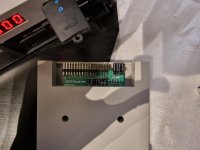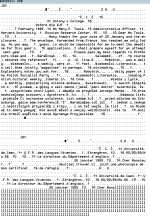HanJammer
Experienced Member
I was given a combat mission to archive disks containing letters from a certain oppositionist from the communist era - this is probably the only preserved copy.
My Schneider CPC6128 reads the disks correctly - now the question is to transfer them to the PC.
I prepared a centronics 36 <-> IDC34 cable compatible with the image here:
 www.cpcwiki.eu
www.cpcwiki.eu
To copy the disks to images.
Generally, the drive works "a little":
|b - allows you to go to it, cat shows the contents of the image, but trying to start the image from the image ends with the error "disc missing" - and subsequent attempts to access the drive cause this error (turning off the computer does not help - you also have to restart GOTEK). Once I managed to copy files from A to B under CP/Mem (using PIP.COM).
The built-in drive A works correctly
I also noticed that access to drive A is related to the activity of drive B (the diode blinks) and vice versa - drive B activity causes some activity of drive B.
I checked the cable with a multimeter, tightened it again twice...
I'm out of ideas.
PS: I also have Greaseweazle and I can finally connect the 3" drive to it and copy the disk images, but I'm not sure what cable I need (although I ordered IDC26 plugs just in case) - similar to here? https://www.fvempel.nl/3pc.html
I have until Friday to do it, then the disks will go back to the archive and probably be forgotten there or demagnetized after a few years.
I
My Schneider CPC6128 reads the disks correctly - now the question is to transfer them to the PC.
I prepared a centronics 36 <-> IDC34 cable compatible with the image here:
DIY:Floppy Drives - CPCWiki
To copy the disks to images.
Generally, the drive works "a little":
|b - allows you to go to it, cat shows the contents of the image, but trying to start the image from the image ends with the error "disc missing" - and subsequent attempts to access the drive cause this error (turning off the computer does not help - you also have to restart GOTEK). Once I managed to copy files from A to B under CP/Mem (using PIP.COM).
The built-in drive A works correctly
I also noticed that access to drive A is related to the activity of drive B (the diode blinks) and vice versa - drive B activity causes some activity of drive B.
I checked the cable with a multimeter, tightened it again twice...
I'm out of ideas.
PS: I also have Greaseweazle and I can finally connect the 3" drive to it and copy the disk images, but I'm not sure what cable I need (although I ordered IDC26 plugs just in case) - similar to here? https://www.fvempel.nl/3pc.html
I have until Friday to do it, then the disks will go back to the archive and probably be forgotten there or demagnetized after a few years.
I


